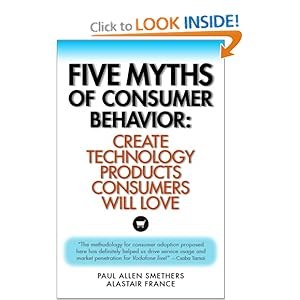Just finished reading “Five Myths of Consumer Behavior“, and I think it is excellent.
The book is a short 145 pages (the pages are physically small and there’s lots of whitespace). There’s no bullshit language in here to confuse things — it is all plainly written, which makes it even more valuable. Also they give direct advice on how to think about a product to get around the problems you might run across.
As the title says, there are five myths (and a few extra chapters offering good ideas):
- Consumers behave the same in all markets
- The more consumers see it, the more successful it will be
- If I’ll use it, my users will
- Consumers will find a product’s value
- Consumers want more features
For me, the first few pages had me hooked because of the “consumers behave the same in all markets” myth. I went in expecting it to say something like “consumers in India buy less beef than Americans”, but it had a much broader (and in retrospect, insanely obvious) lesson. If people are finding a product for the first time, they will approach it from a very different mindset than someone who has seen/used the product before. This includes how people make the initial decision to try something, the purchasing decision, and ongoing use. The authors do a great job of breaking each of these down and explaining the psychology of each one, as well as what you should do about it.
Myth 2 is useful in marketing (or more accurately, in avoiding marketing at the wrong time in a product’s life). There’s a common belief that “we’re not selling enough because people don’t know about it” that I’ve run into many times in business. Sometimes it’s not that people don’t know about it, it’s that people really don’t want it (or they don’t see the value).
An even simpler way of saying it is this: you could buy a prime time Super Bowl ad for a company selling turds, and 98 percent of people watching will still not buy it (the 2% of farmers watching the ad might be interested in some organic fertilizer, as long as you market it as such). As with the other chapters, there’s more explanation worth reading.
Myth 3 is one of the most painful. I’ve got a background in engineering, and I know a lot of engineers, so it hits home more than the others. The engineering problem is this: engineers judge things based on “does it solve the problem? yes/no?”. A consumer judges things based on “does it solve the problem with an acceptable level of effort on my part? yes/no?”
One person will look at a product and say “wow, this really solves problem X!”, and another person will say “uh, yeah I guess, but it’s not worth it to me”. Again, this is something that sounds obvious, but they fill out the idea with lots of very useful info — the percentage of people that fall into the “not worth it to me” group is higher than you think, and they break it down nicely in the book.
Myth 4 comes down to this: if you’ve got a gold bar, and there are enough locked doors in the way, people will go someplace else. Your product is probably not gold bars. You can’t rely on people to dig to figure out what’s useful about the thing you’re offering (yes, this ties into Myth 3). Consumers are busy, and they don’t care about your product nearly as much as you think they do (because your brain lies to you).
Myth 5 (“Consumers want more features”) is something that is valuable (again, their breakdown of the myth is worth the 15 pages you’ll need to read it), but seems to be fading away. The book was published in 2007, and since then, the rise of Apple has given people a concrete example of “less is more”.
I expect that my friends who work in User Experience are most likely to read the book and nod in agreement the whole way through. Tragically, the people who need this book the most are probably going to be the least likely to buy it. In particular, engineers/inventors are a very susceptible group to some of these myths, but I think any entrepreneur could benefit.
It’s not just a book about product design, it’s also got useful marketing and psychology lessons blended in (for example, the end of the book explains why you should check into a hotel and ask for the nosiest room instead of the quietest).
Definitely worth the few hours of reading, and it’s a better value if you pick up a used copy with Amazon Prime shipping.

2 thoughts on ““Five Myths of Consumer Behavior””